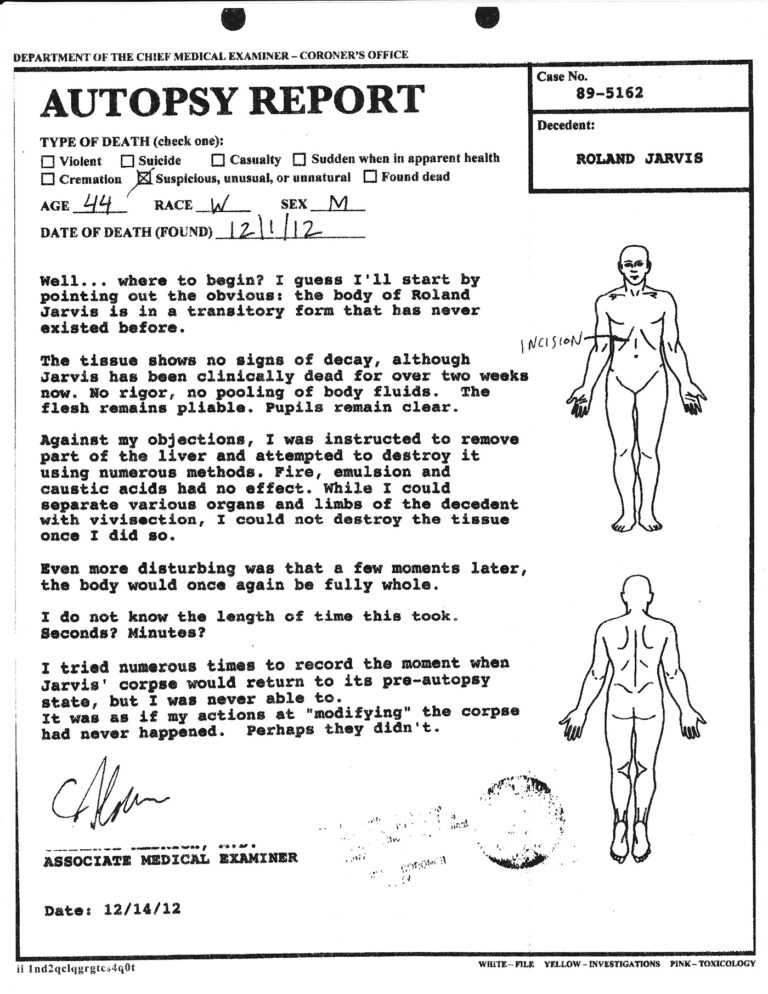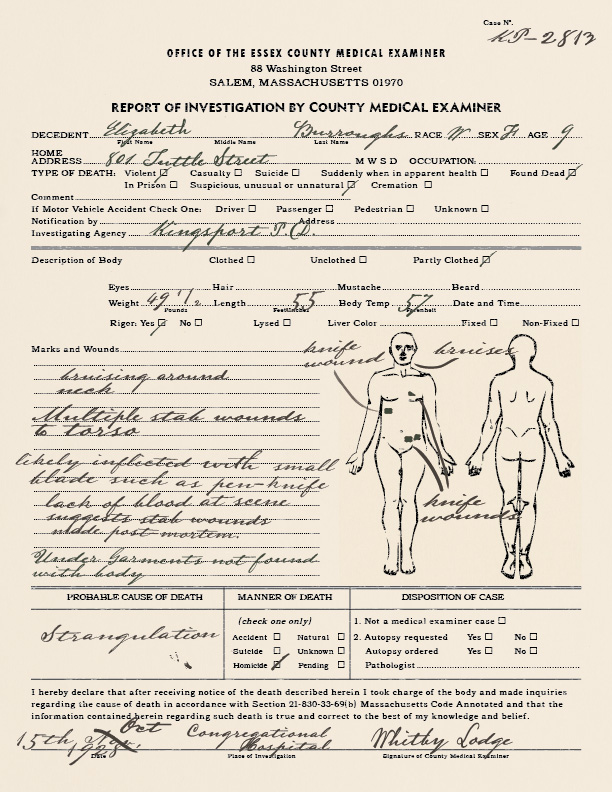Unveiling The Bizarre Autopsy Of Tarrare: The Enigma Of Pica
What is a Tarrare Autopsy Report?
A Tarrare autopsy report is a medical document that details the findings of an autopsy performed on Tarrare, a French performer and entertainer who was known for his unusual eating habits and bizarre medical conditions.
The report provides a detailed description of Tarrare's body, including his organs and digestive system. It also documents the various medical conditions that Tarrare suffered from, including a rare condition known as pica, which led him to consume non-food items such as stones, metal, and live animals.
The Tarrare autopsy report is an important historical document that provides valuable insights into the life and medical conditions of a truly unique individual.
In addition to its historical value, the Tarrare autopsy report has also been used by medical researchers to study the effects of pica and other eating disorders.
Tarrare Autopsy Report
The Tarrare autopsy report is a fascinating and informative document that provides valuable insights into the life and medical conditions of a truly unique individual. Here are six key aspects of the report that are worth exploring:
- Medical history: Tarrare had a long and complicated medical history, including a rare condition known as pica, which led him to consume non-food items such as stones, metal, and live animals.
- Autopsy findings: The autopsy revealed that Tarrare's body was in a state of extreme emaciation, with his stomach and intestines being greatly enlarged. His liver and spleen were also enlarged, and his lungs were congested.
- Cause of death: The autopsy determined that Tarrare died from tuberculosis, which was likely exacerbated by his pica and other medical conditions.
- Historical significance: The Tarrare autopsy report is an important historical document that provides valuable insights into the medical conditions of a unique individual.
- Research value: The report has also been used by medical researchers to study the effects of pica and other eating disorders.
- Cultural impact: Tarrare's story has been told and retold for centuries, and he has become a popular figure in literature and popular culture.
The Tarrare autopsy report is a complex and fascinating document that provides valuable insights into the life and medical conditions of a truly unique individual. It is a valuable resource for medical researchers and historians, and it continues to fascinate people to this day.
Medical history
Tarrare's medical history is an important part of his autopsy report because it provides context for his unusual eating habits and bizarre medical conditions. The autopsy report documents the various medical conditions that Tarrare suffered from, including pica, which is a rare condition that leads people to consume non-food items. The report also describes the physical effects of pica on Tarrare's body, including his extreme emaciation and enlarged stomach and intestines.
The autopsy report also provides insights into the possible causes of Tarrare's pica. The report notes that Tarrare had a history of mental illness, and that he may have been using pica as a way to cope with his psychological distress. The report also suggests that Tarrare's pica may have been caused by a physical condition, such as a nutrient deficiency.
The Tarrare autopsy report is a valuable resource for medical researchers and historians. It provides unique insights into the life and medical conditions of a truly unique individual. The report also highlights the importance of understanding the medical history of patients, as it can provide valuable clues to their current medical conditions and treatment options.
Autopsy findings
The autopsy findings in the Tarrare autopsy report are significant because they provide a detailed description of the physical effects of Tarrare's unusual eating habits and bizarre medical conditions. The findings are consistent with the symptoms of pica, a rare condition that leads people to consume non-food items. The findings also suggest that Tarrare may have been suffering from other medical conditions, such as malnutrition and tuberculosis.
- Extreme emaciation: Tarrare's body was in a state of extreme emaciation, which means that he was severely underweight. This is likely due to the fact that Tarrare's body was unable to absorb nutrients from the non-food items that he consumed.
- Enlarged stomach and intestines: Tarrare's stomach and intestines were greatly enlarged. This is likely due to the fact that Tarrare's body was constantly trying to digest the non-food items that he consumed.
- Enlarged liver and spleen: Tarrare's liver and spleen were also enlarged. This is likely due to the fact that these organs were working overtime to try to filter out the toxins from the non-food items that Tarrare consumed.
- Congested lungs: Tarrare's lungs were congested. This is likely due to the fact that Tarrare was suffering from tuberculosis, which is a bacterial infection that affects the lungs.
The autopsy findings in the Tarrare autopsy report provide valuable insights into the life and medical conditions of a truly unique individual. The findings are a reminder of the importance of understanding the medical history of patients, as it can provide valuable clues to their current medical conditions and treatment options.
Cause of death
The cause of death listed in the Tarrare autopsy report is significant because it provides a definitive answer to the question of how Tarrare died. The report states that Tarrare died from tuberculosis, which is a bacterial infection that affects the lungs. The report also notes that Tarrare's tuberculosis was likely exacerbated by his pica and other medical conditions.
- Pica: Pica is a rare condition that leads people to consume non-food items. Tarrare's pica likely contributed to his tuberculosis by damaging his digestive system and making him more susceptible to infection.
- Other medical conditions: Tarrare suffered from a number of other medical conditions, including malnutrition and mental illness. These conditions likely weakened his immune system and made him more vulnerable to tuberculosis.
The Tarrare autopsy report provides valuable insights into the life and death of a truly unique individual. The report highlights the importance of understanding the medical history of patients, as it can provide valuable clues to their current medical conditions and treatment options.
Historical significance
The Tarrare autopsy report is an important historical document because it provides a unique glimpse into the life and medical conditions of a truly unique individual. The report documents Tarrare's bizarre eating habits, his pica, and his other medical conditions. It also provides insights into the possible causes of Tarrare's death.
The Tarrare autopsy report is a valuable resource for medical researchers and historians. It provides unique insights into the life and medical conditions of a truly unique individual. The report also highlights the importance of understanding the medical history of patients, as it can provide valuable clues to their current medical conditions and treatment options.
The Tarrare autopsy report is a fascinating and informative document that provides valuable insights into the life and medical conditions of a truly unique individual. It is a valuable resource for medical researchers and historians, and it continues to fascinate people to this day.
Research value
The Tarrare autopsy report is a valuable resource for medical researchers studying the effects of pica and other eating disorders. The report provides a unique glimpse into the life and medical conditions of a truly unique individual who suffered from a rare and debilitating condition.
- Pica: Pica is a rare condition that leads people to consume non-food items. The Tarrare autopsy report provides a detailed description of Tarrare's pica, including the types of non-food items that he consumed and the physical effects of his condition. This information is invaluable to medical researchers studying the causes, symptoms, and treatment of pica.
- Other eating disorders: The Tarrare autopsy report also provides insights into other eating disorders, such as anorexia nervosa and bulimia nervosa. Tarrare's extreme emaciation and bizarre eating habits are consistent with the symptoms of these disorders. The report provides a unique opportunity for medical researchers to study the similarities and differences between pica and other eating disorders.
- Medical complications: The Tarrare autopsy report also documents the various medical complications that Tarrare suffered from as a result of his pica and other eating disorders. These complications included malnutrition, tuberculosis, and mental illness. The report provides valuable insights into the potential health risks associated with pica and other eating disorders.
- Treatment options: The Tarrare autopsy report can also be used to inform the development of treatment options for pica and other eating disorders. The report provides a unique glimpse into the challenges of treating these disorders, and it can help medical researchers to identify new and more effective treatment approaches.
The Tarrare autopsy report is a valuable resource for medical researchers studying the effects of pica and other eating disorders. The report provides a unique glimpse into the life and medical conditions of a truly unique individual, and it can help medical researchers to better understand the causes, symptoms, and treatment of these disorders.
Cultural impact
The cultural impact of Tarrare's story is significant because it demonstrates the enduring fascination with the bizarre and the unusual. Tarrare's story has been told and retold for centuries, and he has become a popular figure in literature and popular culture. This is likely due to the fact that Tarrare's story is both fascinating and disturbing. He was a man with an insatiable appetite who could eat anything, and his bizarre eating habits and medical conditions have made him a popular subject of study for medical researchers and historians.
The Tarrare autopsy report is an important part of Tarrare's story. The report provides a detailed description of Tarrare's body and his medical conditions. It also provides insights into the possible causes of Tarrare's bizarre eating habits and his death. The autopsy report is a valuable resource for medical researchers and historians, and it has also been used by writers and artists to create works of fiction and non-fiction about Tarrare.
The cultural impact of Tarrare's story is a reminder of the enduring fascination with the bizarre and the unusual. Tarrare's story is a unique and disturbing tale that has captured the imagination of people for centuries. The autopsy report is an important part of Tarrare's story, and it provides valuable insights into the life and death of a truly unique individual.
FAQs on Tarrare Autopsy Report
This section addresses frequently asked questions and clears misconceptions surrounding the Tarrare autopsy report, providing concise and informative answers.
Question 1: What is the Tarrare autopsy report?
Answer: The Tarrare autopsy report is a medical document detailing the findings of an autopsy performed on Tarrare, a French performer known for his unusual eating habits and bizarre medical conditions.
Question 2: What does the autopsy report reveal about Tarrare's medical conditions?
Answer: The report documents Tarrare's extreme emaciation, enlarged stomach and intestines, enlarged liver and spleen, and congested lungs, indicating pica and potential complications like malnutrition and tuberculosis.
Question 3: What caused Tarrare's death?
Answer: The autopsy determined that Tarrare died from tuberculosis, aggravated by his pica and weakened immune system due to malnutrition and other medical conditions.
Question 4: What is the historical significance of the autopsy report?
Answer: The report provides valuable insights into the medical conditions of a unique individual, contributing to the understanding of rare conditions like pica and their potential health risks.
Question 5: How has the autopsy report impacted medical research?
Answer: Researchers have utilized the report to study the effects of pica and other eating disorders, aiding in the development of treatment approaches for these conditions.
Question 6: Why is Tarrare's story so captivating?
Answer: Tarrare's bizarre eating habits and medical conditions, coupled with the detailed autopsy report, have made his story a subject of fascination in literature and popular culture, highlighting the enduring interest in the unusual and unexplained.
Summary: The Tarrare autopsy report is a significant historical document offering insights into a unique medical case. It has contributed to medical research on eating disorders and captured public imagination, showcasing humanity's enduring fascination with the extraordinary.
Transition to the next article section: Explore further aspects of the Tarrare autopsy report and its implications in the subsequent sections.
Tips on the Tarrare Autopsy Report
The Tarrare autopsy report is a fascinating medical document that provides valuable insights into a unique and bizarre medical case. Here are some tips for understanding and utilizing this report:
Tip 1: Read the report carefully and thoroughly.
The Tarrare autopsy report is a complex and detailed document. It is important to read the report carefully and thoroughly in order to fully understand the findings. Pay attention to the specific details and observations, as well as the overall conclusions.
Tip 2: Consult with a medical professional.
If you have any questions about the Tarrare autopsy report, it is best to consult with a medical professional. A doctor can help you to interpret the findings and explain the medical significance of the report.
Tip 3: Use the report for research purposes.
The Tarrare autopsy report is a valuable resource for medical researchers. The report can be used to study the effects of pica and other eating disorders. It can also be used to study the medical history of Tarrare and other individuals with similar conditions.
Tip 4: Be aware of the limitations of the report.
The Tarrare autopsy report is a valuable document, but it is important to be aware of its limitations. The report is based on a single autopsy, and it is possible that some details were missed or misinterpreted. It is also important to remember that the report was written in a different time and place, and some of the medical practices and beliefs described in the report may be outdated.
Tip 5: Respect the privacy of Tarrare and his family.
The Tarrare autopsy report is a public document, but it is important to respect the privacy of Tarrare and his family. Do not share the report without their consent, and be respectful of their feelings about the report.
Summary: The Tarrare autopsy report is a valuable and fascinating medical document. By following these tips, you can better understand and utilize this report for your own research or other purposes.
Transition to the article's conclusion: The Tarrare autopsy report is a reminder of the importance of medical research and the enduring fascination with the human body.
Conclusion
The Tarrare autopsy report is a fascinating and informative document that provides valuable insights into a unique and bizarre medical case. The report details the findings of an autopsy performed on Tarrare, a French performer known for his unusual eating habits and medical conditions. The report documents Tarrare's extreme emaciation, enlarged stomach and intestines, enlarged liver and spleen, and congested lungs, indicating pica and potential complications like malnutrition and tuberculosis.
The Tarrare autopsy report is a valuable resource for medical researchers and historians. It provides unique insights into the medical conditions of a unique individual and contributes to the understanding of rare conditions like pica and their potential health risks. The report also highlights the importance of understanding the medical history of patients, as it can provide valuable clues to their current medical conditions and treatment options.
Article Recommendations


